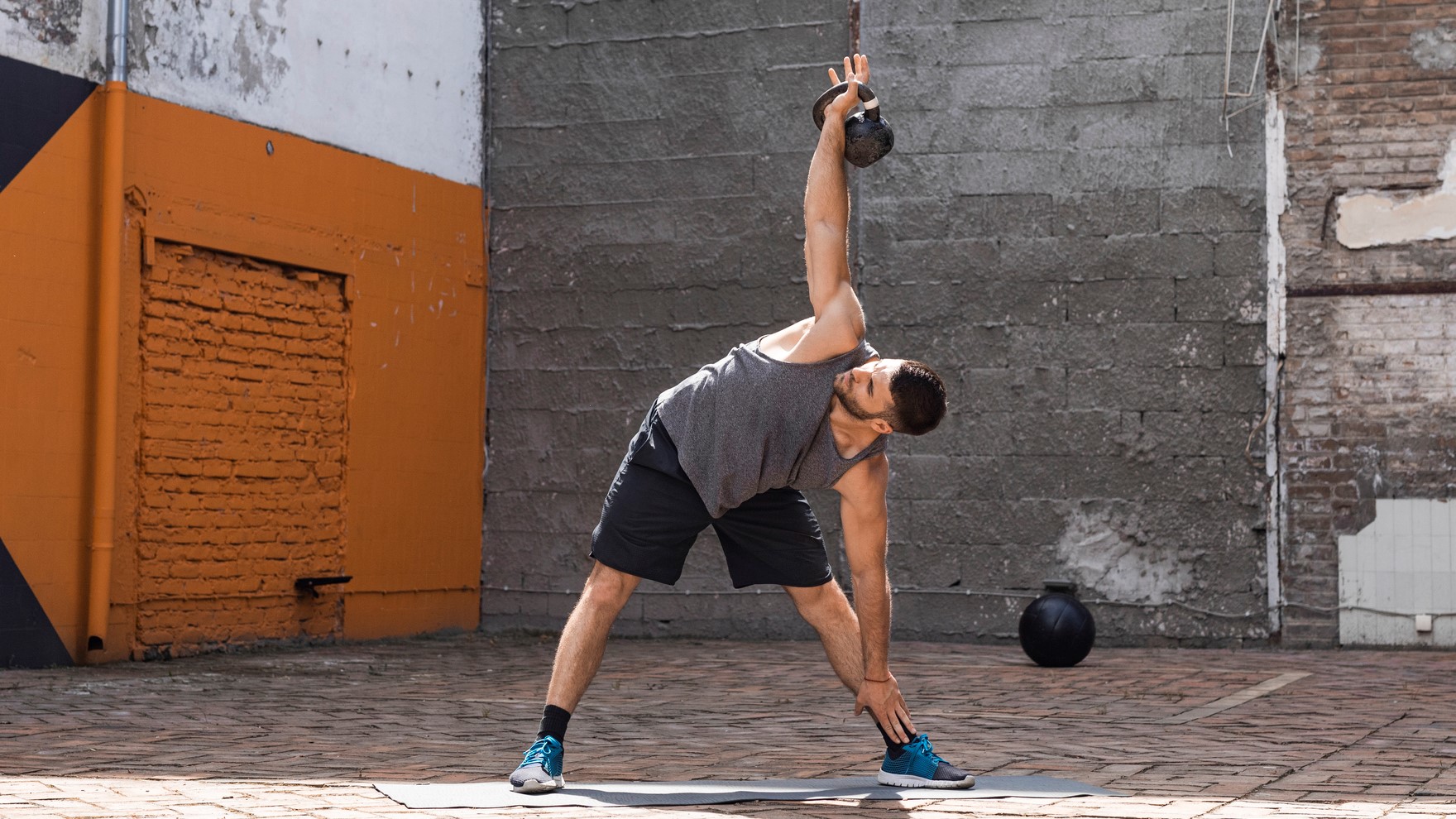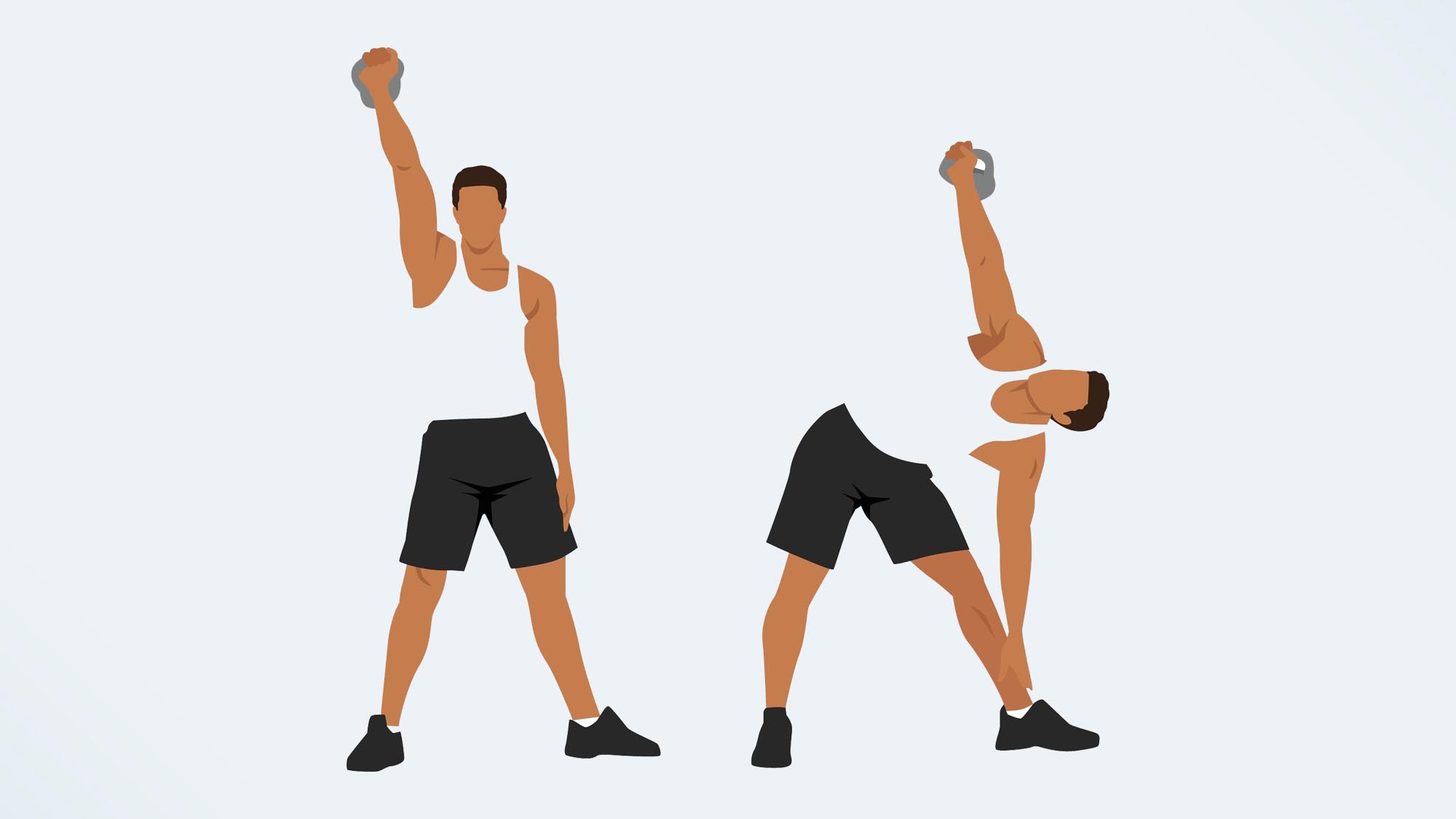I did kettlebell windmills every day for a week — here’s what happened
Kettlebell windmills strengthen more than just your core

When it comes to fitting in a good workout, a lot of us can feel pressed for time. Exercises that work multiple muscle groups at once are an effective and efficient option to strengthen the whole body, and kettlebell windmills do just that.
While kettlebell windmills have long been lauded as a way to target core muscles like your internal and external obliques, they’re also a great way to strengthen your glutes, hamstrings, back, and shoulders (especially the stabilizing muscles like your rhomboids and rotator cuff). Additionally, kettlebell windmills can improve mobility and provide an excellent stretch for several areas of your body. And as the name implies, you’ll only need a single kettlebell to perform the exercise — check out the best kettlebells to buy for working out at home here.
My calendar has been pretty full lately, so I’ve had to shorten my usual workouts in order to fit everything in. I decided to perform kettlebell windmills every day for a week to see if I could get similar full-body strengthening results as I do with my normal routines.
However, it’s important to keep in mind that performing the same exercise every day is rarely advised — appropriate rest and recovery is vital for building muscle strength and growth. If you’ve just started to workout regularly, schedule a session or two with a certified personal trainer to be sure you’re executing the movement correctly.
How to do kettlebell windmills
Grab a kettlebell while we review the proper form:

- Select a light or moderately heavy kettlebell and stand with your feet shoulder-width apart.
- Pick up the kettlebell with your left arm and raise it into the air, letting the bell rest on top of your left wrist and keeping your arm straight. Ensure that your left shoulder is rolled back and your lats are engaged.
- Turn both of your feet to the right at a 45-degree angle.
- Look up at the kettlebell above you, and keep your focus on the bell for the entirety of the movement.
- Engage your core and shift your left hip behind you, allowing your right knee to bend slightly.
- Rotate your right arm from the shoulder, placing your knuckles against the inner thigh of your right leg. Slide your right arm along the inner thigh, reaching your fingertips towards the floor.
- Once you’ve reached the end of your range, lift back up to the starting position with control.
- Repeat for 10-12 repetitions before performing the exercise on the other side, remembering to angle your feet away from the kettlebell.
Kettlebell windmills are great for the whole body, but you’ll want to watch out for a few common form mistakes. Make sure that the kettlebell stays aligned directly over your shoulder joint — don’t allow it to stray in front of your body or behind your head. Keep your spine straight with no curving through the lower or mid-back. Finally, keep your knees bent at a slight angle without going past 90 degrees. If you notice any of these compensations happening, reduce your range of motion or select a lighter kettlebell. You can also choose to practice the movement unweighted for a few reps, before picking up a kettlebell.
I did kettlebell windmills every day for a week — here’s what happened
Knowing my schedule would be fairly busy for a while, I was excited to see what a week’s worth of daily kettlebell windmills could do with limited workout time. My goal was to perform two sets of 12 repetitions on each side. Here’s what happened:
Sign up to get the BEST of Tom's Guide direct to your inbox.
Get instant access to breaking news, the hottest reviews, great deals and helpful tips.
My shoulders were sore
I knew kettlebell windmills targeted the shoulders, but it wasn’t until I started doing them every day that I realized just how much that was true.
Waking up on the morning of day two, I felt like I’d spent the previous afternoon going for maximal efforts on my overhead presses. Both of my shoulders ached in a “good sore” kind of way — nowhere near debilitating pain, but enough to let me know I was putting in some decent work. As I anticipated, that soreness eventually decreased as the week progressed.
It took some time for my back to acclimate
My lumbar spine gives me trouble with nearly every exercise I attempt, so this wasn’t a huge shocker. I woke up on the morning of days two and three with some pain in my lower back, so I decided to warm up for a few more minutes and reduce my range of motion on the windmill.
This seemed to do the trick — my back calmed down considerably by day four, and I was able to return to my normal range of motion on day five. By day seven, I was actually able to increase my range a bit.
I increased my kettlebell weight by the end of the week
As I mentioned, my shoulders were pretty sore at the beginning of the week. Once that started to fade however, I felt confident enough to grab a heavier kettlebell for the remaining days.
Performing kettlebell windmills with a heavier weight is what really kicked my obliques into gear. I hadn’t really “felt” them in those first few days of the exercise, although obviously I knew they were working. By the end of the week, I felt them a lot more — both during the exercise and after.
My squats and deadlifts felt easier
I had the opportunity to squeeze in a short leg day towards the end of the week, and I was surprised at how my daily kettlebell windmill practice had affected my lower body strength.
Despite their value and importance, I don’t look forward to squats and deadlifts — I have to be super cautious because of my cranky lower back, and overall they’re just very challenging exercises for me. However, after several days of kettlebell windmills I found both of these exercises to be noticeably easier. This was especially the case for my deadlifts, where I could really see the improvements in my glute and hamstring strength.
The verdict? The kettlebell windmill is a pretty intense exercise that targets a lot of muscles at once, so I don’t think I’ll be doing them daily again. But because of the positive developments I noticed in my shoulders, glutes, and core, I’ll be adding them into my routine for a few days every week.
More from Tom's Guide
Jennifer Rizzuto is a freelance writer and certified personal trainer based in Long Island, NY. She covers various fitness-related topics and reviews for Tom's Guide. She also writes sketch comedy and short films, and performs frequently as an actor, singer, and improviser. When she's not writing, working out, or performing, you'll find her trying to convince her husband to get a dog.

